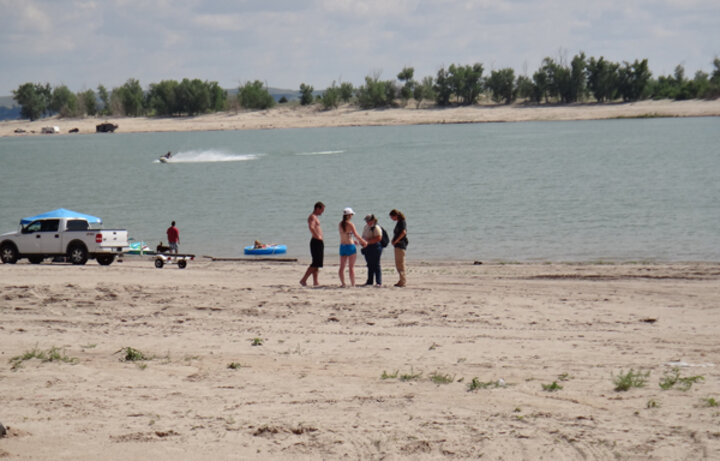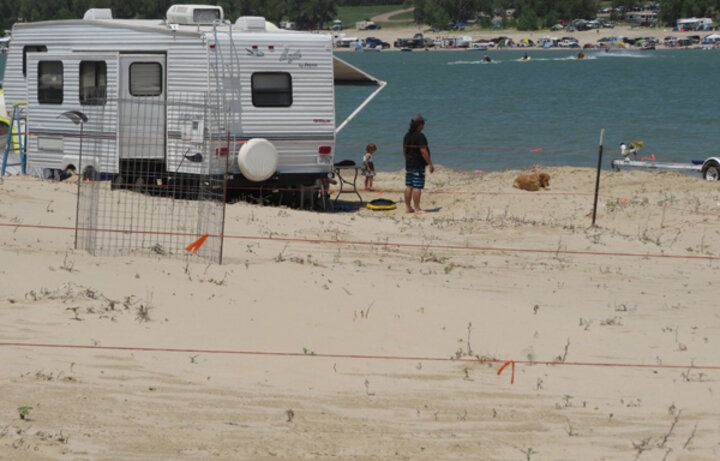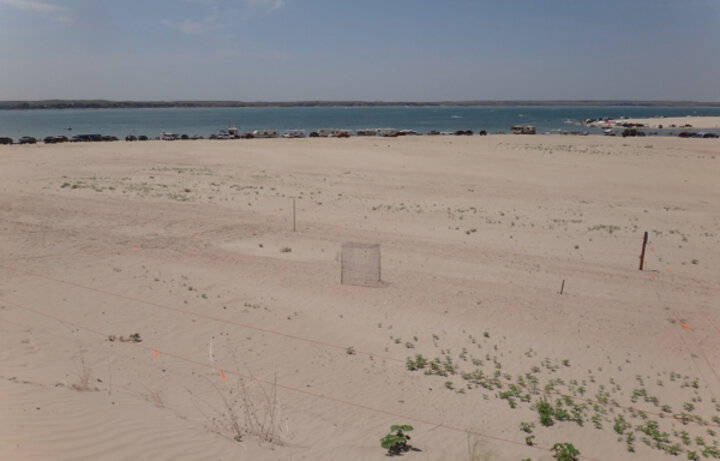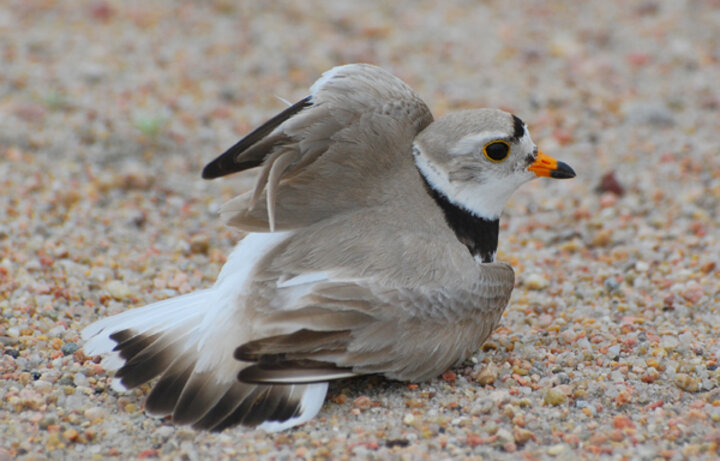Evaluating interactions between Piping Plovers and humans at Lake McConaughy
In 2012, concerns were raised about the effectiveness of existing protections for the Piping Plovers that nest on the wide sandy beaches at Lake McConaughy, near Ogallala, Keith County, in western Nebraska. The human-created reservoir is one of the most important nesting areas for the birds in the Great Plains. The number of nesting plovers varies from year to year and is linked to lake water levels and the resulting amount of exposed beach. When lake water levels are low, Piping Plover numbers can be as high as the low 100s and when the water levels are high, only a dozen or two birds may be present. A few Least Terns can be found nesting at Lake McConaughy, as well.
The key variable impacting Piping Plovers at Lake McConaughy is the number of people who visit the lake for recreation, mostly boating, fishing, swimming, and camping. Over the past 25 years, the number of people coming to the lake has doubled and now more than one million people visit the lake every year, most during the plover nesting season (May-August). During holiday weekends more than 70,000 people may be enjoying the sun and sand at the lake at any one time —often very near plover and tern nests. As the number of people has increased in the same physical space where threatened and endangered species occur, it leads, not surprisingly, to more conflicts and management challenges.
In 2013, the TPCP teamed up with the Nongame Bird Program at the Nebraska Game and Parks Commission to develop a research project (Joel Jorgensen and Mary Bomberger Brown, project PIs) to better understand interactions between people and Piping Plovers at Lake McConaughy. Very early in project design, we recognized that the threatened and endangered species management challenges at Lake McConaughy were mostly about people, not birds. Consequently, we based the project on the many practical Human Dimensions lessons we learned during our years working at sand and gravel mines and lakeshore housing developments (see Thody et al. 2009; Brown et al 2011; for more information). We focused on using Human Dimensions principals to better define the challenges we were faced with and then to identify solutions. Since our formal training and experience was focused on bird biology rather than the social sciences, it was necessary to delve into the HD primary literature. We found Fishbein and Ajzen’s (1975) theory of reasoned action and its extension, the theory of planned behavior (Ajzen 1985; also see Ajzen 1992) and the theory of behavior change (Fishbein and Manfredo 1992) useful as we devised the personal interview surveys and observations included in our study. Combining the Human Dimensions literature and the ornithological and management literature with our practical experience led to our successful research project and ongoing management program.
Our Human Dimensions research focused first on defining and understanding visitors’ awareness and attitudes about Piping Plovers, their legal protections and restrictions placed on recreation intended to protect the birds. As we learned more about the social environment, we evolved our efforts to deliver information to managers and decision-makers that could be used to avoid conflicts and enhance social acceptance of the birds. Our research is influencing how threatened and endangered species personnel, park staff, and regulatory agency personnel communicate and interact with visitors to Lake McConaughy. Our research has led managers and agencies to consider how management strategies could be made more effective. Although evaluation of the effectiveness of these re-envisioned strategies is still in progress, dog leash law compliance at Lake McConaughy significantly increased from 2013 to 2016 as has awareness of and appreciation for the birds.
Piping Plovers are protected by the Endangered Species Act and routinely nest on sandy beaches--areas that are also valued by humans for recreation--along the Atlantic Coast and Great Lakes and in the Great Plains. Setting aside beaches for Piping Plovers in recreation areas, and excluding people from those areas, frequently leads to misunderstandings and conflicts. Often conflict prevention and management relies on simply providing information to the individuals affected by the recreation restrictions. This solution assumes the problem is based the public’s lack of knowledge. Increasing law enforcement is often seen as punishing people and leads to more negative feelings toward the birds. We believe the solution to the problem is more complex. The goal of managers should be to not only improve the public’s environmental literacy, but also their acceptance of wildlife, including legally protected species. Incorporating Human Dimensions into the management of Piping Plovers and other protected species, so that social challenges are properly diagnosed and resolved, can lead to better, more sustainable outcomes that benefit both people and the species.
- Ajzen, I. 1985. “From intentions to actions: A theory of planned behavior”. In Springer Series in Social Psychology, ed. J. Kuhl and J. Beckmann, 11–39. Berlin:Springer Publishing.
- Ajzen, I. 1992. “Persuasive communication theory in social psychology: A historical perspective.” In Influencing human behaviour, ed. M. J. Manfredo, 1-28. Champaign, IL: Sagamore Publishing
- Brown, M. B., M.E. Burbach, J. Dinan, R. Held, R. Johnson, J.G. Jorgensen, J.L. Lackey, J. Marcus, G.S. Matkin and C. Thody. 2011. Nebraska’s Tern and Plover Conservation Partnership – a model for sustainable conservation of threatened and endangered species. Wader Study Group Bulletin 118: 118: 22-25.
- Fishbein, M., and I. Ajzen. 1975. Belief, attitude, intention and behavior: an introduction to theory and research. Reading, MA: Addison-Wesley.
- Fishbein, M., and M. J. Manfredo. 1992. “A theory of behavior change.” In Influencing Human Behavior: Theory and Applications in Recreation, Tourism and Natural Resources Management, ed. M. J. Manfredo. Urbana, IL: Sagamore Publishing.
- Thody, C.M., R.J. Held, R.J. Johnson, J.F. Marcus, and M.B. Brown. 2009. “Grassroots conservation: volunteers contribute to threatened and endangered species projects and foster a supportive public.” Journal of Extension (http://www.joe.org/joe/2009february/)
The TPCP and the Nongame Bird Program at the NGPC recently completed a four-year study (2013-17) evaluating interactions between Piping Plovers and recreationists at Lake McConaughy. The following publications resulted from the study:
- Jorgensen, J.G., and M. Bomberger Brown. 2017. Evaluating persuasive messages to influence dog leash law compliance at a public recreation area in the Great Plains. Great Plains Research.
- Jorgensen, J.G., L.R. Dinan & M.B. Brown. 2016. Flight initiation distances of nesting Piping Plovers (Charadrius melodus) in response to human disturbance. Avian Conservation and Ecology 11(1):5. http://dx.doi.org/10.5751/ACE-00826-110105
- Jorgensen, J.G. & M.B. Brown. 2016. Impact perceptions and acceptance capacity toward Piping Plovers (Charadrius melodus) among visitors on a public beach in Nebraska, USA. Wader Study 123: 59-68. doi:10.18194/ws.00029
- Jorgensen. J.G. & M. Bomberger Brown 2015. Evaluating recreationists awareness and attitudes towards Piping Plovers (Charadrius melodus) at Lake McConaughy, Nebraska, USA. Human Dimensions of Wildlife 20: 367-380.
- Jorgensen, J.G. & M. Bomberger Brown. 2014. Piping Plovers (Charadrius melodus) and dogs: compliance with and attitudes towards a leash law on public beaches at Lake McConaughy, Nebraska, USA. Wader Study Group Bulletin 121: 71-76.


Conflicts
The conflicts which arose from terns and plovers nesting at sand and gravel mines and lakeshore housing developments in eastern Nebraska led to the formation of the Tern and Plover Conservation Partnership. Instrumental to the TPCP’s success are the partners who recognize working proactively and cooperatively to prevent conflicts, rather than reactively when things go wrong is the best way forward. Since 1999, when the TPCP formed, this point has been reaffirmed time and time again.

Complex Lake McConaughy
Lake McConaughy exists in a complex regulatory environment. The lake was formed by the closing of Kingsley Dam on the North Platte River in 1941 with the intention of providing water for crop irrigation in central Nebraska. The dam supports a hydroelectric power generating facility operated under Federal Energy Regulatory Commission license No. 1417. License conditions require the Central Nebraska Public Power and Irrigation District to protect threatened and endangered species, including Piping Plovers and Least Terns, and to provide recreational opportunities for the public, in addition to water for irrigation. The area surrounding the lake is leased to the Nebraska Game and Parks Commission, which manages public recreation. Piping Plovers and Least Terns nesting at Lake McConaughy are protected in consultation with the U.S. Fish and Wildlife Service and the Nebraska Game and Parks Commission.

Lessons Learned
Major research results from the Lake McConaughy project:
- Nearly half of all visitors (48%) to Lake McConaughy were residents of the Front Range Urban Corridor (FRUC) that extends from Cheyenne, Wyoming to Colorado Springs, Colorado, including the Denver metropolitan area. These visitors travel 2-3 hours to reach Lake McConaughy. Far fewer visitors were local residents (26%). The "weekend infux" of visitors from the FRUC presents major challenges since there are limited opportunities to inform and engage them.
- Slightly more than half of all visitors were aware of Piping Plovers and their protected status-- a large proportion of visitors knew little, if anything, about the birds despite existing information and education efforts.
- Visitors unaware of the presence of Piping Plovers or their status strongly supported protecting the species.
- Increased awareness about the presence of Piping Plovers was associated with negative attitudes toward them. Thus, there is a negative side to awareness — the danger that some visitors will feel inconvenienced by the plovers when they become aware of them and their protected status.
- Lack of information regarding the presence of a leash law was shown not to be a barrier to individuals leashing their dogs. Nearly 80% of visitors were aware of an existing leash law, but only 16% of dogs observed were leashed in 2013-14. A shift in management tactics led to a sharp increase in leash law compliance, up to 67% in 2016.
- An evaluation of several potential messages intended to persuade visitors to leash their dogs showed that a message emphasizing human and pet safety (avoiding dog bites and fights) was more effective than messages emphasizing avoiding negative impacts to wildlife, citations/fines, saving agencies money, social pressure and norms, among others.